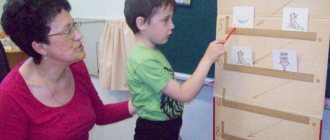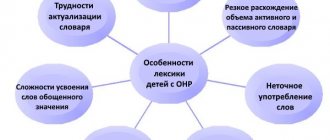A child masters speech through hearing, so it is very important to pay attention to the development of auditory perception . Games for the development of auditory perception contribute to the fact that the child begins to listen to surrounding sounds, the words of people close to him, his attention increases, and his memory improves.
Examples of games for the development of auditory perception .
Younger age:
- “Who’s screaming?” (An adult depicts the sounds of either baby domestic animals or their mothers, and the child guesses, names or shows the picture).
- “Kolobok” (the adult speaks for the hare, bear and fox in different voices, “Kolobok, Kolobok, I’ll eat you!”, and the child guesses).
-The same thing with the fairy tale “The Three Bears” - guess who says “Who was sitting on my chair?”
For middle and older children:
-Guess the sound of musical instruments (tambourine, pipe, drum, bell, rattle, harmonica).
-Guessing sounds when tapping a pencil on a metal box, glass jar, plastic glass, wooden box/table.
- Kinder cases with bulk products.
- “Who flies (swims, runs), a series of words are pronounced: falcon, milk, fish, mosquito... children clap their hands at the right moment.
- “Who came to us?”
A number of similar words are named, one of them is repeated many times, and children mark it with predetermined onomatopoeia. For example, the word nail among others: goose, bone, bush, bunch, growth, cane, throw; children's response is “knock-knock” or imitation of hammering nails.
- "Telephone".
The teacher calls a word or a simple tongue twister to the first child from each row; On command, those sitting in front turn back and pass on what was said to the next children.
The row in which the words reach the last child faster and without distortion receives a “challenge prize” - a flag, an asterisk...
children take part in the version of the game described below .
The teacher names four similar words, for example: point, barrel, daughter, hummock. Four guys take turns calling one word (dot, barrel, daughter, hummock, and the fifth says the first word of this series, etc. (There should be one less word than the number of players.) Whoever makes a mistake goes to the table to complete an individual task .
- “Name it, don’t yawn!”
Children receive two pictures, the names of which are similar in sound composition. The teacher pronounces the words, and the one who has the desired picture responds with a conditional phrase: “I have a poppy (varnish, onion, branch),” etc.
- “Find the mistake”
The bug didn’t finish the booth: it was reluctant, it was tired.
The snow is melting, the stream is flowing, the branches are full of doctors.
There are no roads in the swamp, I jump and jump over the cats.
2. Performing finger exercises has a positive effect on speech development (especially at a young age).
-Performing exercises and rhythmic movements with your fingers leads to stimulation in the speech centers of the brain, which stimulates speech development .
-Finger games teach you to listen and understand the meaning of speech , and increase the child’s speech activity.
— Finger gymnastics develops a child’s attention and memory, as he learns to remember certain hand positions and movements.
3. For correct sound pronunciation, it is necessary to perform articulatory gymnastics. Articulation gymnastics - exercises for training the organs of articulation (lips, tongue, lower jaw). Thanks to timely articulation gymnastics, some children themselves can learn to speak clearly and correctly, without the help of a specialist.
4. The development of speech is facilitated by breathing exercises, which are aimed at developing a long, smooth exhalation. Shallow breathing - there is enough air for one or two words (sometimes speech is interrupted even mid-sentence) can lead to stuttering. For this purpose , it is recommended to blow on toys floating in a basin, blow into a tube, the end of which is lowered into a glass of water, blow on a thread with something light hanging on the end, etc. Make sure to inhale through your nose without tension, do not stretch your shoulders. rise, exhale through the mouth, lips are pulled forward, cheeks do not puff out. Please note: to avoid dizziness caused by depletion of oxygen in the brain, the number of repetitions is no more than 4-5 times.
5. For the development of coherent speech, vocabulary work and improvement of grammatical structure are important. The names of objects, their parts, details are entered into the active dictionary; colors and their shades; shape, size and material from which they are made. The child learns to answer questions, naming both objects and their signs and actions. Children's vocabulary is replenished not only with nouns, but also with other parts of speech : adjectives, verbs, adverbs , numerals. When selecting material for classes, the age characteristics of the child are taken into account.
6. The child masters the grammatical forms of the language primarily in communication with others, in the process of enriching and activating the vocabulary, and the formation of coherent speech . Through didactic games and exercises, children's is drawn to those grammatical aspects, the acquisition of which causes them certain difficulties. These include errors in changing nouns by case: no boots, pencils instead of boots, pencils; there are no calves, goslings instead of calves, goslings. Gross mistakes were noted during approval: my dress, two little foxes, on a green tree and much more. Mastery of all these grammatical forms begins as early as three years of age.
Conclusion: correct pronunciation of sounds, along with a rich vocabulary and grammatically correct, well- developed coherent speech, is one of the indicators of a child’s readiness for schooling.





